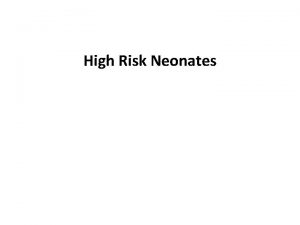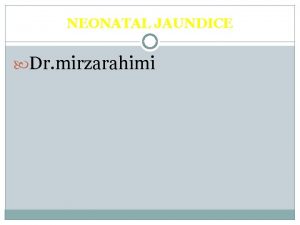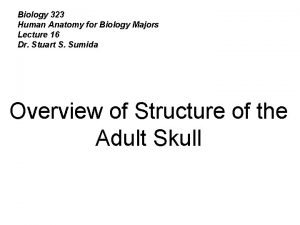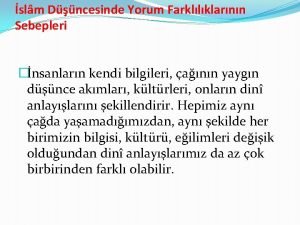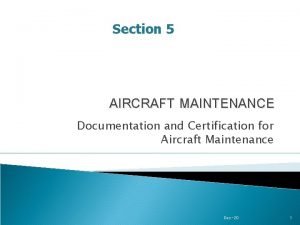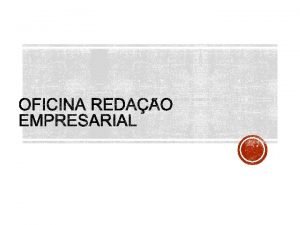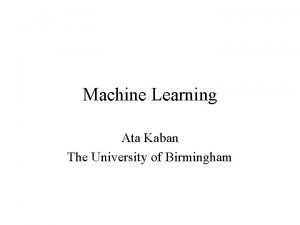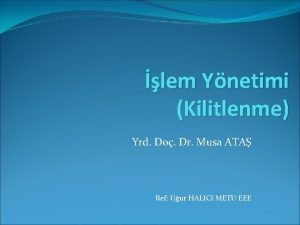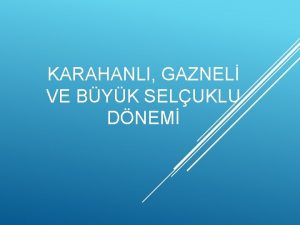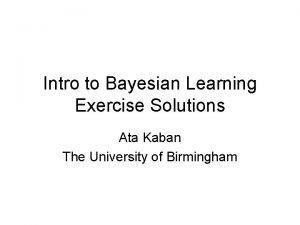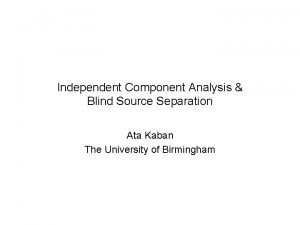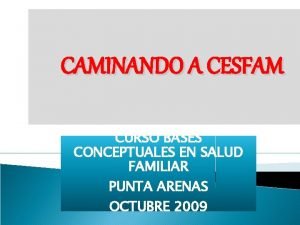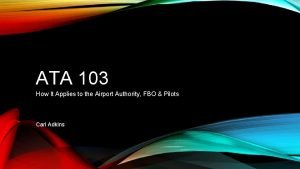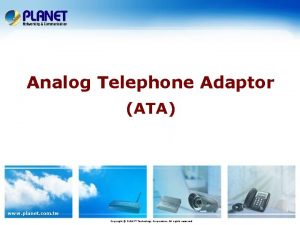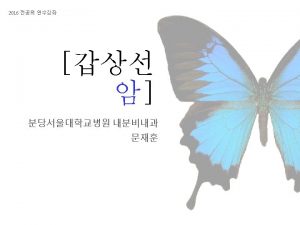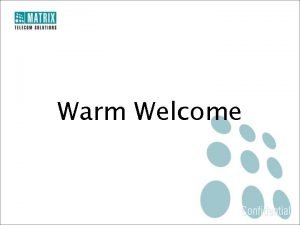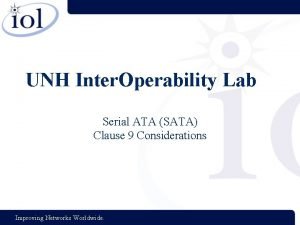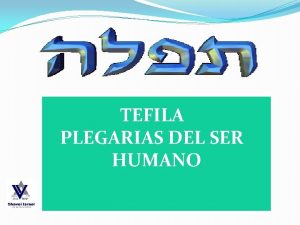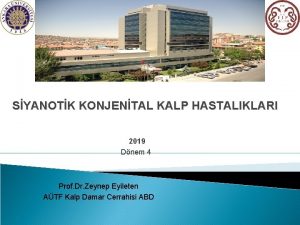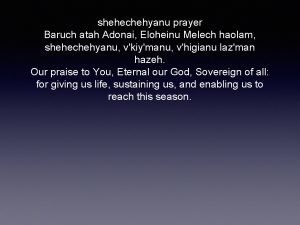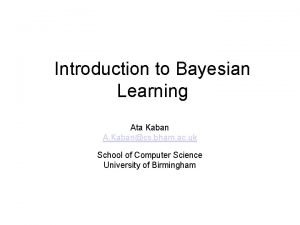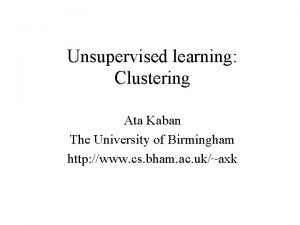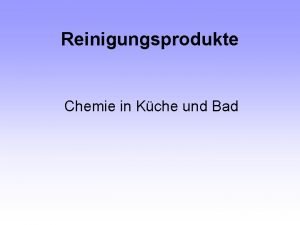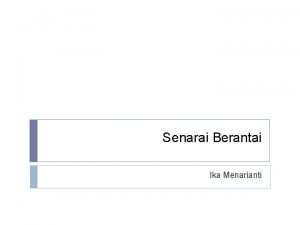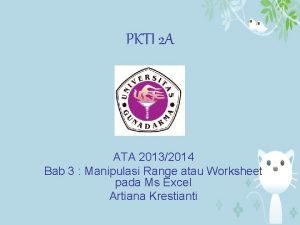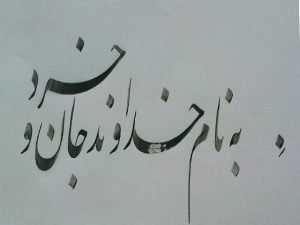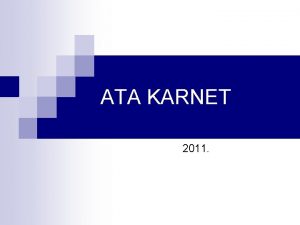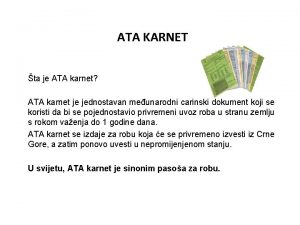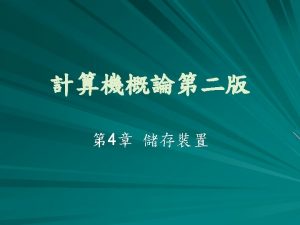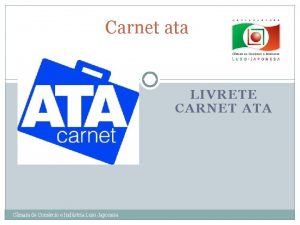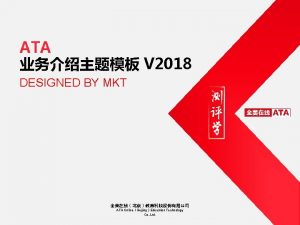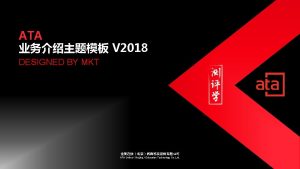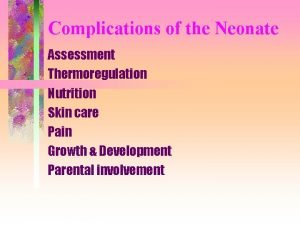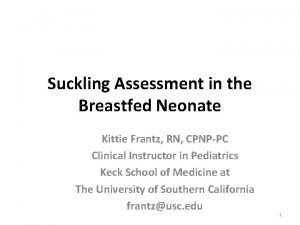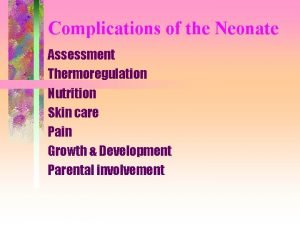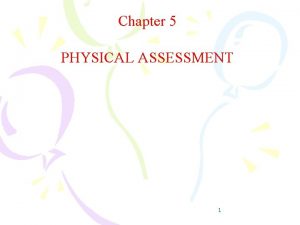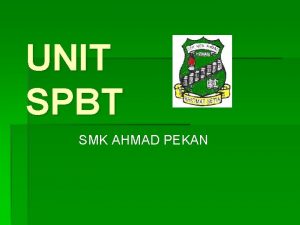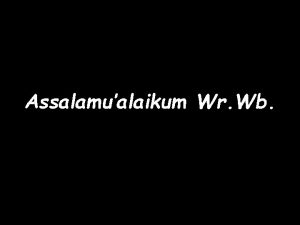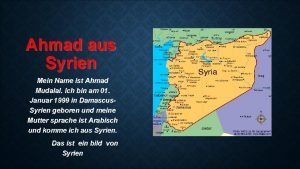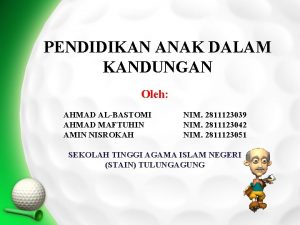Physical Assessment for neonate Mr Ahmad Ata 1










































































































- Slides: 106

Physical Assessment for neonate Mr. Ahmad Ata 1

Nursing Health History

1) Bio-graphic Demographic • • • Name, age, health care provider Parents name age /siblings age Ethnicity / cultural practices Religion / religious practices Parent occupation

2) Chief complain • To establish the major specific reason for the child’s and parant’s seeking professional health attention 4

3. History of present illness • To obtain all detials related to chief complaint • Seven attributes 4. Past History • • • Allergies Childhood illness Trauma / hospitalizations Birth history, pregnancy and delivery Did baby go home with mom / special care nursery Genetics: anything in the family

5. Family history • Any underlying illness / genetic condition. 6. Review of systems • Ask questions about each system • Measuring data: growth chart, head circumference, BMI • Nutrition: breast fed, formula, eating habits • Growth and development: How does parent think child is doing?

Vital Signs Mr. Ahmad Ata 7

What are vital signs? • Vital signs include heart rate, respiration (breathing rate), blood pressure, and temperature.

Infant and Toddler Vital Sign Measurement 1) Count respirations FIRST (before disturbing the child) 2) Count apical HR SECOND 3) Measure BP (if applicable) THIRD 4) Measure temperature LAST

Temperature • Body temperature is the difference between heat produced by internal processes and heat lost through the external environment.

Temperature • There are several ways to take child’s temperature. The American Academy of Pediatrics no longer recommends mercury thermometers because these glass thermometers may break and, as their mercury vaporizes, it can be inhaled, resulting in toxic levels. Digital electronic thermometers are better choices.

Types of thermometer • Digital electronic: oral and axillary • Infrared: tympanic – another acceptable choice. it accuracy depends on the ability of the beam emitted by the device to reach the eardrum. • Chemical (e. g. Tempa-dot) • Mercury or glass thermometer

Temperature Position for taking axillary temperature. Mr. Ahmad Ata 13

Ear (Tympanic) Temperature • Can also be affected by: – Impacted ear wax & ear infections • Should NOT be used if child had ear surgery

Temperature Ø Oral temperature for children over 5 to 6 years. Ø Rectal temperatures are contraindicated if the child has had anal surgery, diarrhea, or rectal irritation. Ø Normal temp : 36. 5 -37. 5 Mr. Ahmad Ata 15

Position for Rectal tempreture • To take the temperature in your child’s bottom (rectally), then put a small amount of lubricant, such as petroleum jelly, on the small end of it. Place child on something firm, either faceup or facedown (if he’s facedown, put one hand on his back; if he’s faceup, bend your child’s leg to his chest,

Heart rate • The pulse is a wave of dilation - the wave of blood, created by the heart pumping that travels along the arteries • Where to find pulse: • At points where the artery is between fingertips and a bony area • Called pulse points • Felt with two or three fingers but never the thumb 17

Heart rate Pulse sites: • Temporal, Carotid, Radial, Ulnar, Brachial, Apical, Femoral, Popliteal, Dorsal Pedis, Posterior tibial. • Notes: • Carotid most common in emergencies. • Radial most common for routine examination. • Apical pulse provides a more accurate assessment of heart function, particularly when tachycardia present 18

Heart rate Apical pulse for infants and toddlers under 2 years Count for 1 full minute Will be increased with: crying, anxiety, fever, and pain Mr. Ahmad Ata 19

Pulse rates • • Neonate: 100 – 180 1 -year: 100 – 160 3 years: 80 - 110 14 years 60 - 100 Mr. Ahmad Ata 20

Apical Pulse Mr. Ahmad Ata 21

Pulse - Brachial • Used for infants and small children • Place fingertips of first 2 or middle 3 fingers over the brachial pulse area – Inside of the elbow • Lightly press your fingertips on the pulse area

Respiration • The exchange of gases between a living organism and its environment. • The mechanical act of breathing in air (inspiration) and expelling air (expiration) from the body. Normal Respirations: • Effortless • Regular • Smooth 23

Respiratory • Count for one full minute • May want to do before you wake the infant up • Rate will be elevated with crying / fever – Newborn: 30 – 60 – Toddler: 25 - 40 – School-age: 18 - 30 – Adolescent: 16 - 20 Mr. Ahmad Ata 24


Blood Pressure • The width of the rubber bladder should cover two thirds of the circumference of the arm, and the length should encircle 100% of the arm without overlap. • Crying can cause inaccurate blood pressure reading. • Consider normal for age. Mr. Ahmad Ata 26

Blood Pressure • Systolic blood pressure is the highest pressure reached in the arteries as the heart pumps blood out for circulation through the body. • Diastolic blood pressure is the much lower pressure that occurs in the arteries when the heart relaxes to take blood in between beats.

Blood Pressure Approximate Age Range Systolic Range Diastolic Range 1 -12 months 1 -4 years 3 -5 years 6 -13 years 75 -100 80 -110 85 -120 50 -70 50 -80 55 -80

Oxygen Saturation • Oxygen Saturation provide important information about cardiopulmonary dysfunction and is considered by many to be a fifth vital sign.

1. General appearance and behavior of new born. Flexion position Head flexed, chin resting on the upper chest, arm flexed with hand clenched and the feet dorsiflexed. Check vital sign Mr. Ahmad Ata 30

a. Skin reddish in color, smooth and puffy at birth At 24 - 36 hours of age, skin flaky, dry and pink in color Edema around eyes, feet, and genitals Turgor good with quick recoil < 2 sec Mongolian spots: are large patches of bluish colored skin with wavy border often seen in sacral area. Bruises, cyanosis Mr. Ahmad Ata 31

a- Skin • Check for color variations—such as increased or decreased • pigmentation, pallor, mottling, bruises, erythema, cyanosis, or jaundice • Some variations in skin color are common and normal, such as freckles found in the white population and Mongolian spots found on dark-skinned

a- Skin • When a skin color abnormality is suspected, inspect the buccal mucosa and tongue to confirm the color change. • Generalized cyanosis is associated with respiratory and cardiac disorders. • Jaundice is associated with liver disorders.

a- Skin Cord clamp tight and cord drying Jaundice, note in seclera Colour of the skin depends on the familial and racial back ground. Texture is soft, smooth skin Rashes, petechia, scar, lesions (describe location, size and characteristics) Mr. Ahmad Ata 34


Skin cont… Mr. Ahmad Ata 36

Skin cont… • Vernix caseosa - The white, cheesy substance covering the newborn's body. Often present only in the skin folds. • Lanugo - Fine downy body hair usually distributed over shoulders, sacral area, and back of newborns. Usually disappears before birth or shortly after birth. Mr. Ahmad Ata 37

b. Head Contour of the head. Six bones: Frontal bone Occipital bone Two parietal Two temporal bone Between the junction of these bone are bands of connective tissue called Sutures. At the junction of the are wider spaces unossified membranous tissue called Fontanels Mr. Ahmad Ata 38

Head • Expected findings: Anterior fontanel diamond shaped 2 -3 to 3 -5 cm Posterior fontanel triangular 0. 5 - 1 cm Fontanels soft, firm and flat Sutures are fibrous connetions between the bone. Bulging indicates increase intracranial pressure Sunken indicates dehydration Mr. Ahmad Ata 39

Cont … head Check fontanels: – Anterior: 12 to 18 months – Posterior: closes by 2 -3 months • head control usually establish by 6 month Mr. Ahmad Ata 40

Mr. Ahmad Ata 41

b. Hair • Inspect the scalp hair for color, distribution, and cleanliness. • The hair shafts should be evenly colored, shiny, and either curly or straight. Variation in hair color not caused • Normally, hair is distributed evenly over the scalp

C. Eyes • Slate gray or blue eye color • No tears • Fixation at times - with ability to follow objects to midline • Corneal reflex • Distinct eyebrows • Cornea bright and shiny • Pupils equal, reactive to light, round and clear • Hypertelorism: widely spaced eye. Mr. Ahmad Ata 43

Eyes Sclera should be white and clear. Yallowish sclera indicate jaundice strabismus may present Sunken or bulging Strabismus: Alignment of eye important due to correlation with brain development May need to corrected surgically Mr. Ahmad Ata 44

Common variations Edematous Eyelids May focus for a few seconds Uncoordinated movements Mr. Ahmad Ata 45

Signs of potential distress or deviations from expected findings: • • • Discharges Opaque lenses Absence of Red Reflexes absent "Doll's Eyes" Reflex (beyond 10 days of age): When the head is moved slowly to the right or left, the eyes do not follow nor adjust immediately to the position of the head. Mr. Ahmad Ata 46

Ears • • Ears Expected findings: Loud noise elicits Startle Reflex Flexible pinna with cartilage present Pinna top on horizontal line with outer canthus of eye, if pinna is lower outer canthus may indicate congenital anomalies Mr. Ahmad Ata 47

Ear Exam • . pulled down and back to straighten ear canal in children under 3 years Mr. Ahmad Ata 48

Nose • • Expected findings: Nostrils patent bilaterally Obligate nose breathers No nasal discharge Common variations: • Sneezes to clear nostrils • Thin white nasal mucus discharge Mr. Ahmad Ata 49

Mouth and Throat Expected findings: Uvula midline Minimal or absent salivation Tongue moves freely and does not protrude Well developed fat pads bilateral cheeks Sucking reflex Rooting reflex Gag reflex Mr. Ahmad Ata 50

Mouth and Throat • Mucosa moist. Shortly after birth may visualize sucking calluses on central portions of lips. • Palate high arched: • Cleft lip or cleft palate • Common variations: • Epstein's pearls on ridges of gums Mr. Ahmad Ata 51

Common variations: • Epstein's pearls on ridges of gums, small, white. • Lingual frenulum: tight. • Frenuloplasty • Uvula can be inspected when open mouth. Mr. Ahmad Ata 52

Neck Expected findings: Short and thick Turns easily side to side Clavicles intact Tonic neck reflex present Some head control Mr. Ahmad Ata 53

Neck Range of motion. Shape. Abnormal mass. Palpate clavicle for fracture Palpable crepitus, movement with palpation of clavicle Torticollis-stiff neck: difficulty in holding head straight. Mr. Ahmad Ata 54

Chest Expected findings: Protruded xiphoid process. Shape is circular: Equal anteroposterior and lateral diameter. Ribs are very flexible and slight intercostal retraction Bilateral synchronous chest movement Mr. Ahmad Ata 55

Chest • Breast: Ø Size, shape and nipple formation. Ø Location symmetry. Ø With’s milk. Mr. Ahmad Ata 56

Breast Signs of potential distress or deviations from expected findings: Asymmetrical chest movements Sternum depressed Marked retractions Absent breast tissue Flattened chest Nipples widely spaced Bowel sounds auscultated Mr. Ahmad Ata 57

Lungs The normal respiration are irregular and abdominal. The rate is between 30 - 60 b/m. Irregulataries occur during crying, sleeping and feeding. Bronchial equal bilaterally Crackles soon after birth may indicate presence of fluid. Wheezing or stridor. Mr. Ahmad Ata 58

Wheeze or Stridor • Wheezes occur when air flows rapidly through bronchi that are narrowed nearly to the point of closure. • Wheezes is lower airway – Asthma = expiratory wheezes • A stridor is upper airway – Inflammation of upper airway or FB Mr. Ahmad Ata 59

Child Chest Mr. Ahmad Ata 60

Chest assessment Retractions Subcostal Intercostal Sub-sternal Supra-clavicular Red flags: grunting / nasal flaring Mr. Ahmad Ata 61


Heart rate: 100 – 180 b/m after birth. The Point of Maximums Impulses (PMI). 4 th to 5 th intercostals space. Give us the location of the heart ( congenital diaphragmatic hernia or hemothorax. Dextrocardia: heart in the right side. Murmur: represents the incomplete functional closure of fetal shunt. Mr. Ahmad Ata 63

Abdomen Shape is cylindrical and with few visible vein. Bowl sound are heard within 15 – 20 m after birth. Umbilical cord presence two arteries and one vein. After clamping, it begins to dry and dull yellowish. If umbilical cord appear unusually in diameter may indicate hematoma or small omphalocele. Mr. Ahmad Ata 64

Abdomen Liver palpable 2 - 3 cm below right costal margin Bilaterally equal femoral pulses Voiding within 24 hours of birth Meconium within 24 - 48 hours of birth Mr. Ahmad Ata 65

Male Genitalia Expected findings: Urinary meatus at tip of glans penis Palpable testes in scrotum Large, edematous, pendulous scrotum, with rugae Stream adequate on voiding Common variations: Prepuce covering urinary meatus Erections Increased pigmentation Edema and ecchymosis after breech delivery Mr. Ahmad Ata 66

Male Genitalia Smegma: a white cheesy substance is commonly around the glans penis. Epithelial pearls: small, white firm lesion may be seen at the tip of prepuce Mr. Ahmad Ata 67

Signs of potential distress or deviations from expected findings: Non palpable testes Hypospadius Epispadius Scrotum smooth Ambiguous genitalia inguinal hernia. Mr. Ahmad Ata 68

Female Genitalia Expected findings: Edematous labia and clitoris Labia majora are larger and surrounding labia minora Vernix between labia Common variations: Hymenal tag Pseudomenstruation Increased pigmentation Ecchymosis and edema after breech birth. Mr. Ahmad Ata 69

Signs of potential distress or deviations from expected findings: Labia fused Fecal discharge from vaginal opening Ambiguous genitalia Widely separated labia Mr. Ahmad Ata 70

Back and Rectum Expected findings: • Intact spine without masses or openings • Patent anal opening • "Wink reflex" present Signs of potential distress or deviations from expected findings: • Limitation of movement • Spina bifida • Imperforate anus • Anal fissures • Pilonidal cyst Mr. Ahmad Ata 71

Extremities Expected findings: Maintains posture of flexion Equal and bilateral movement and tone Full range of motion all joints Ten fingers and ten toes Grasp reflex present Legs appear bowed Mr. Ahmad Ata 72

Feet appear flat Palmar creases present Sole creases present Mr. Ahmad Ata 73

• Signs of potential distress or deviations from expected findings: • Unequal tone • Asymmetrical movement of extremities • Syndactyly • Unequal leg length • Asymmetrical skin creases posterior thigh • • Dislocation of hip • Persistent cyanosis of nail beds • Polydactyly Mr. Ahmad Ata 74

APGAR TEST Mr. Ahmad Ata 75

What is it? • A test developed in 1952 by Dr. Virginia Apgar • A baby’s first test • Quick assessment of the newborn’s overall well-being • Given one-minute after birth and five minutes after birth • Rates 5 vital areas Mr. Ahmad Ata 76

Why is it done? • To assess the baby’s vital signs quickly • The score is helpful for later evaluations

The 5 Signs: 1. The baby’s color Color: a. Pale or blue = 0 b. Normal color body, but blue extremities (arms and/or legs) = 1 c. Normal color = 2 – completely pink Mr. Ahmad Ata 78

2. The baby’s respiratory effort Respiration: a. Not breathing = 0 b. Weak cry, irregular breathing = 1 c. Strong cry = 2 • 2 points for a strong cry • 1 point for a slow or weak cry • 0 points for no cry at all Mr. Ahmad Ata 79

3. The baby’s heart rate Heart Rate: a. Absent heartbeat = 0 b. Slow heartbeat (less than 100 beats/minute) = 1 c. Adequate heartbeat (more than 100 beats/minute) = 2 • 2 = good strong heartbeat • 1 = slow but steady heartbeat • 0 = little or no heartbeat Mr. Ahmad Ata 80

4. The baby’s muscle tone Muscle Tone: a. Limp, flaccid = 0 b. Some flexing or bending = 1 c. Active motion = 2 • 2 points for vigorous motion • 1 point for small flexing • 0 points for no movement

5. The baby’s reflexes Response to Stimulation a. No response = 0 b. Grimace (facial expression) = 1 c. Vigorous cry or withdrawal = 2 • 2 points if the baby cries • 1 point if the baby grimaces (facial expression) • 0 points for no movement or sound Mr. Ahmad Ata 82


APGAR Score Interpretation Score 8 – 10 ( Eight to ten ) Intervention • No intervention is required 4– 7 ( Four to seven ) • Gently stimulate • Rub newborn’s back • Administer O 2 to the newborn. • Infant requires resuscitation 0– 3 ( Zero to three )

Example • A newborn assessed using APGAR scoring system, found with heart rate = 120 bpm, slow and weak cry, well flexed, the newborn found crying and sneezing as a response , and pale …. . how much in APGAR? And what will be your intervention ? .

Answer The sign Newborn’s findings 120 bpm The score Respiratory effort Muscle tone Slow, weak cry 1 Well flexed 2 Reflex irritability Skin color Sneeze , cry 2 Pale 0 Heart rate Total 2 7 ? ? ? !!!

Growth Measurements Lab 3 Mr. Ahmad Ata 87

Introduction • Measurement of physical growth in children is a key element in evaluation of the health status of children. • Physical growth parameters include height, weight, and head circumference. • Over all evaluation of growth requires judgment in interpretation of growth percentiles.

Physical growth parameter 1. 2. 3. 4. 5. Weight Height / length Skin fold Head circumferences Chest circumferences Mr. Ahmad Ata 89

Weight Note close proximity of nurses hands for safety Mr. Ahmad Ata 90

Weight • Needs to be recorded on a growth chart • Newborn may lose up to 10% of birth weight in 3 -4 days. • Too much or too little weight gain needs to be further investigated. • Double birth weigh by 5 -6 months • Triple birth weight by 1 year • Nutritional counseling • The normal birth weight is 2700 - 4000 g. Mr. Ahmad Ata 91

Weight-for-age percentiles, boys 0 to 24 months, WHO growth standards Mr. Ahmad Ata 92

Mr. Ahmad Ata 93

Length Measurement Infants Mr. Ahmad Atahead is against end point and legs fully extended. 94

Length-for-age percentiles, boys birth to 24 months, WHO growth standards Mr. Ahmad Ata 95

Mr. Ahmad Ata 96

Height Measurement Child is measured while standing in stocking or bare feet with the heels back and shoulders touching the wall. Mr. Ahmad Ata 97

Stature-for-age percentiles, boys, 2 to 20 years, CDC growth charts: United States Mr. Ahmad Ata 98

Mr. Ahmad Ata 99

Head Circumference Head circumference is measured by wrapping the paper tape over the eyebrows and the around the occipital prominence. Mr. Ahmad Ata 100

Head circumference-for-age percentiles, boys 0 to 24 months, WHO growth standards Mr. Ahmad Ata 101

Head circumference is measured in children from birth to 3 years of age because this is the period of rapid brain growth. Head circumference also should be measured in older children with abnormal growth because it may be helpful in determining the etiology. A child with fetal alcohol syndrome, as an example, may have growth deficiency and microcephaly. The measurement should be plotted on a standardized growth chart. Mr. Ahmad Ata 102

Head, chest, and abdominal circumference. Mr. Ahmad Ata 103

Mr. Ahmad Ata 104

Normal Growth measures • Head circumference : 33 - 35. 5 cm • Chest circumference : 30. 5 - 33 cm, 2 cm less than head circumference. • Length: head (cephalic) to heal: 48 - 53 cm • Body weight : 2700 - 4000 g. ( loses 10% of weight in the first 3 to 4 days after birth).

What is failure to thrive • Children who are unable to thrive do not receive or are unable to adopt, maintain, or use the calories, was supposed to gain weight and grow as expected. Mr. Ahmad Ata 106
 Neonatal bradycardia algorithm
Neonatal bradycardia algorithm High risk neonates definition
High risk neonates definition Petechiae neonate
Petechiae neonate Priformus
Priformus Fspos
Fspos Typiska novell drag
Typiska novell drag Nationell inriktning för artificiell intelligens
Nationell inriktning för artificiell intelligens Returpilarna
Returpilarna Varför kallas perioden 1918-1939 för mellankrigstiden
Varför kallas perioden 1918-1939 för mellankrigstiden En lathund för arbete med kontinuitetshantering
En lathund för arbete med kontinuitetshantering Kassaregister ideell förening
Kassaregister ideell förening Tidbok för yrkesförare
Tidbok för yrkesförare Anatomi organ reproduksi
Anatomi organ reproduksi Densitet vatten
Densitet vatten Datorkunskap för nybörjare
Datorkunskap för nybörjare Stig kerman
Stig kerman Att skriva debattartikel
Att skriva debattartikel Autokratiskt ledarskap
Autokratiskt ledarskap Nyckelkompetenser för livslångt lärande
Nyckelkompetenser för livslångt lärande Påbyggnader för flakfordon
Påbyggnader för flakfordon Vätsketryck formel
Vätsketryck formel Publik sektor
Publik sektor Lyckans minut erik lindorm analys
Lyckans minut erik lindorm analys Presentera för publik crossboss
Presentera för publik crossboss Vad är ett minoritetsspråk
Vad är ett minoritetsspråk Plats för toran ark
Plats för toran ark Klassificeringsstruktur för kommunala verksamheter
Klassificeringsstruktur för kommunala verksamheter Epiteltyper
Epiteltyper Bästa kameran för astrofoto
Bästa kameran för astrofoto Cks
Cks Byggprocessen steg för steg
Byggprocessen steg för steg Bra mat för unga idrottare
Bra mat för unga idrottare Verktyg för automatisering av utbetalningar
Verktyg för automatisering av utbetalningar Rutin för avvikelsehantering
Rutin för avvikelsehantering Smärtskolan kunskap för livet
Smärtskolan kunskap för livet Ministerstyre för och nackdelar
Ministerstyre för och nackdelar Tack för att ni har lyssnat
Tack för att ni har lyssnat Referatmarkeringar
Referatmarkeringar Redogör för vad psykologi är
Redogör för vad psykologi är Matematisk modellering eksempel
Matematisk modellering eksempel Atmosfr
Atmosfr Borra hål för knoppar
Borra hål för knoppar Vilken grundregel finns det för tronföljden i sverige?
Vilken grundregel finns det för tronföljden i sverige? Stickprovsvariansen
Stickprovsvariansen Tack för att ni har lyssnat
Tack för att ni har lyssnat Rita perspektiv
Rita perspektiv Ledningssystem för verksamhetsinformation
Ledningssystem för verksamhetsinformation Tobinskatten för och nackdelar
Tobinskatten för och nackdelar Toppslätskivling dos
Toppslätskivling dos Mästare lärling modell
Mästare lärling modell Egg för emanuel
Egg för emanuel Elektronik för barn
Elektronik för barn Fredsgudinna pax
Fredsgudinna pax Strategi för svensk viltförvaltning
Strategi för svensk viltförvaltning Kung dog 1611
Kung dog 1611 Humanitr
Humanitr Romarriket tidslinje
Romarriket tidslinje Tack för att ni lyssnade
Tack för att ni lyssnade Matte större än tecken
Matte större än tecken Vad är prosa
Vad är prosa Inköpsprocessen steg för steg
Inköpsprocessen steg för steg Rbk-mätning
Rbk-mätning Etik och ledarskap etisk kod för chefer
Etik och ledarskap etisk kod för chefer Slyngexcision
Slyngexcision Myndigheten för delaktighet
Myndigheten för delaktighet Trög för kemist
Trög för kemist Sju principer för tillitsbaserad styrning
Sju principer för tillitsbaserad styrning Läkarutlåtande för livränta
Läkarutlåtande för livränta Karttecken
Karttecken Geometri för barn
Geometri för barn Shaktismen
Shaktismen Var finns arvsanlagen
Var finns arvsanlagen Bris för vuxna
Bris för vuxna Jätte råtta
Jätte råtta Ata offshore
Ata offshore Honeytoken accounts ata
Honeytoken accounts ata Ata de eleição ssvp
Ata de eleição ssvp Maturidlik
Maturidlik Aircraft schematic manual (asm)
Aircraft schematic manual (asm) Uso de anexo
Uso de anexo Ata kaban
Ata kaban Musa ata
Musa ata American trans air careers
American trans air careers Leşkeri bazar sarayı
Leşkeri bazar sarayı Ata kaban
Ata kaban Aapo hyvärinen
Aapo hyvärinen Atanın oğluna nəsihəti
Atanın oğluna nəsihəti 5 pilar promosi kesehatan
5 pilar promosi kesehatan Apgar familiar minsal
Apgar familiar minsal Ata entry
Ata entry Ata 103
Ata 103 Planet ata
Planet ata Goal of alma ata declaration
Goal of alma ata declaration Ata 2016
Ata 2016 Ata matrix
Ata matrix Inter ata
Inter ata Baruj ata adonai eloheinu melej haolam
Baruj ata adonai eloheinu melej haolam Ata biner aorta
Ata biner aorta Baruch ata adonay elohanu melech haolam
Baruch ata adonay elohanu melech haolam Ata kaban
Ata kaban кабан
кабан Danklorix anwendungsgebiete
Danklorix anwendungsgebiete Ata kaban
Ata kaban Jelaskan tentang ata bian
Jelaskan tentang ata bian Alma ata deklaracija
Alma ata deklaracija A ata
A ata Thyroid tumors
Thyroid tumors

